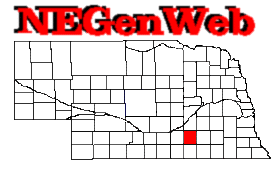

The first marriage in the town was that
of E. J. Jackson to Mary N. Cargill, in the fall of 1874. The first death
was
Edward Harper, in 1864, and the first
child born was Sheridan Bainter, May 11, 1871. The earliest officers in
the
town were L. N. Bryant, Justice of the
Peace, and James Bainter, Constable.
In the spring of 1872, Miss Annie Foster
taught the first school in James Bainter's residence, and, during that
summer, a schoolhouse was built.
The earliest religious services were
held in 1871, in Bainter's house, and were conducted by Elder J. W.
Warwick. In the fall of 1881, the Presbyterians
erected a church, which was directly followed by one belonging
to the Congregationalists.
A post office was established in 1870 and called Spring Ranche; the first Postmaster was Lewis Thayer.
A grist and flouring mill called the
Spring Ranche Mills was built in 1874 by the firm of Peck & Meston.
A store,
comprising a small stock of general
merchandise, was started in 1871 by James Bainter, in his own dwelling,
and
which was the first store in the town.
The early settlers in this part of the
county suffered greatly from depredations by the Indians, having been chased
out at two different times and had all
their property burned up. The first instance of this sort took place on
the 9th
of August, 1864, the settlers having
fled for their lives, but bravely returned after the savages had completed
their
desolations and disappeared, and began
to repair the losses they had sustained and start anew. After the lapse
of
a short time, when they had succeeded
in gathering a few buildings and some property about them, they were
again invaded, in July, 1866, by the
terrifying enemies, and forced to a second flight, while leaving behind
houses
and effects to feed the sportive bonfire
of their assailants. At this time, all the settlers left and none returned
until
the spring of 1870, since which they
have suffered no disturbance from the "noble warriors of the plain."
A more detailed account of these Indian
troubles is to be found in the history of Spring Ranche Precinct as part
of
the general history of the county.